No CrossRef data available.
Published online by Cambridge University Press: 03 October 2016

1 As demonstrated by many articles in W. Scheidel and S. von Reden (edd.), The Ancient Economy (2002), more recently in such works as, for example, W. Scheidel, I. Morris and R. Saller (edd.), The Cambridge Economic History of the Greco-Roman World (2007); Bang, P.F., ‘The Ancient Economy and New Institutional Economics’ JRS 99 (2009), 194–206 Google Scholar; A. Bowman and A. Wilson (edd.), The Roman Agricultural Economy. Organization, Investment, and Production (2013); P. Erdkamp, K. Verboven and A. Zuiderhoek (edd.), Ownership and Exploitation of Land and Natural Resources in the Roman World (2015).
2 See works noted above and, for example, M. Decker, Tilling the Hateful Earth: Agricultural Production and Trade in the Late Antique East (2009).
3 See, for example, P. Erdkamp (ed.), The Roman Army and the Economy (2002).
4 See, for example, O. Karagiorgou, ‘LR2: a Container for the Military Annona on the Danubian Border?’, in S.A. Kingsley and M. Decker (edd.), Economy and Exchange in the East Mediterranean during Late Antiquity (2001), pp. 129–66.
5 See, for example, C. Loveluck, Northwest Europe in the early Middle Ages, c. ad 600–1150: a Comparative Archaeology (2013); H. Hamerow, Rural Settlements and Society in Anglo-Saxon England (2012).
6 A. Verhulst, ‘Le genèse du régime dominial classique en France au Haut Moyen Âge’ in Agricoltura e mondo rurale in occidente nell’ alto medioevo (1966), pp. 135–60; D. Lohrmann, ‘Le moulin à eau: Dans le cadre de l’économie rurale de la Neustrie (VIIe–XIe siècles)’ in H. Atsma (ed.), La Neustrie: Les pays au nord de la Loire de 650 à 850 (1989), pp. 367–404.
7 Summarised in A. Chavarría and T. Lewit, ‘Recent Archaeological Research on the Late-Antique Countryside: a Bibliographic Essay’ in L. Lavan, W. Bowden and C. Machado (edd.), Recent Research on the Late Antique Countryside (2004), pp. 1–51.